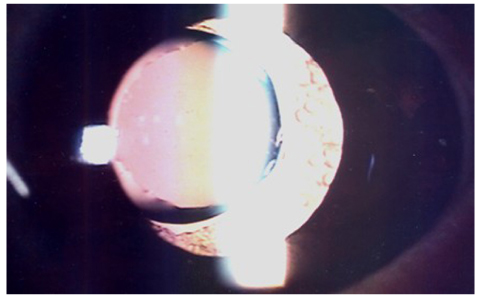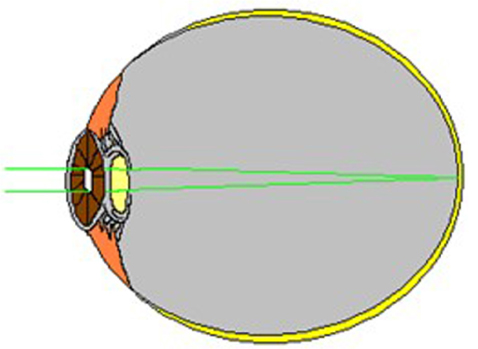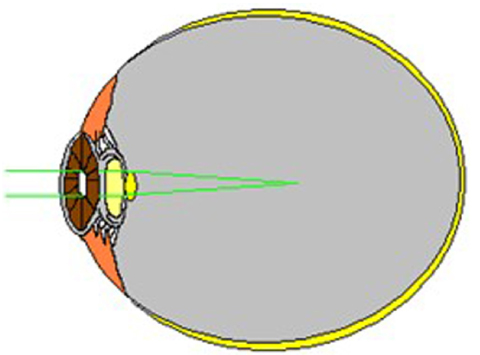Korean J Ophthalmol.
2009 Dec;23(4):309-311. 10.3341/kjo.2009.23.4.309.
Refractive Change Caused Silicone Oil Adhesion to the Intraocular Lens Following Nd:YAG Posterior Capsulotomy
- Affiliations
-
- 1Department of Ophthalmology, Wonju Christian Hospital, Yonsei University Wonju College of Medicine, Wonju, Korea. bswhitey@hanmail.net
- KMID: 754770
- DOI: http://doi.org/10.3341/kjo.2009.23.4.309
Abstract
- A 32-year-old female who had undergone the silicone oil removal procedure presented with visual disturbance in her left eye. Several months previous, she had cataract surgery in a private clinic, and a month later she had a Nd:YAG laser procedure for posterior capsulotomy. The slit-lamp examination revealed silicone oil droplets that had adhered to the intraocular lens where the posterior capsulotomy was performed. She had experienced high myopia as a manifestation of the resulting refractive changes. We replaced the previous intraocular lens with a new acrylic intraocular lens with resulting improvement to her vision. Here we report the case of a female patient with a history of silicone oil removal surgery where the resulting silicone bubbles had not been removed thoroughly and remained in the vitreous cavity. These bubbles subsequently adhered to the intraocular lens following YAG laser posterior capsulotomy, resulting in refractive changes. We recommend that implanting a silicone intraocular lens in anyone with a history of the silicone oil removal procedure or who has a possible history of silicone oil use should be avoided.
Keyword
MeSH Terms
Figure
Reference
-
1. Stefansson E, Anderson MM Jr, Landers MB 3rd, et al. Refractive changes from use of silicone oil in vitreous surgery. Retina. 1988. 8:20–23.2. Smith RC, Smith GT, Wong D. Refractive changes in silicone filled eyes. Eye. 1990. 4:230–234.3. Hotta K, Sugitani A. Refractive changes in silicone oil-filled pseudophakic eyes. Retina. 2005. 25:167–170.4. Eaton AM, Jaffe GJ, McCuen BW 2nd, Mincey GJ. Condensation on the posterior surface of silicone intraocular lenses during fliudair exchange. Ophthalmology. 1995. 102:733–736.5. Glickman GM, Poole TA. Silicone intra ocular lenses during vitrectomy. Arch Ophthalmol. 1987. 105:1166.6. Robertson JE Jr. The formation of moisture droplets on the posterior surface of intraocular lenses during fluid/gas exchange procedures. Arch Ophthalmol. 1992. 110:168.7. Kutner BN. Posterior surface condensation on silicone IOLs. Ophthalmology. 1995. 102:1412.8. Apple DJ, Federman JL, Krolicki TJ, et al. Irreversible silicone oil adhesion to silicone intraocular lenses: a clinicopathologic analysis. Ophthalmology. 1996. 103:1555–1561.
- Full Text Links
- Actions
-
Cited
- CITED
-
- Close
- Share
- Similar articles
-
- Postoperative Capsular Bag Distension in Cataract Surgery
- Transpupillary Silicone Oil Removal through a Posterior Capsulorhexis and Intraocular Lens Implantation
- Comparison of Nd:YAG Capsulotomy Rates between Spherical and Aspheric Intraocular Lenses
- Effect of Diabetes on the Developmental Duration of after-cataract in Pseudophakic Eyes with PMMA or Silicone IOL
- Visual Improvement After Q-switched Nb : YAG Laser Posterior Capsulotomy in After Cataract





